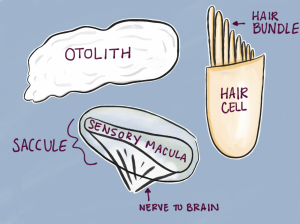Can you hear me now?
Hey everyone, thanks for coming back! Today I want to tell you about acoustic communication. Not only can fish hear, but a lot of us make sounds too! While we don’t actually ‘talk’, like seen in the movies, we do make sounds for a variety of reasons. Different fish produce sounds using different mechanisms, but the purpose is the same: to communicate with other nearby fish. My friend Todd the Toadfish does it to advertise his location and attract females. Like him, I produce sounds when courting the ladies1. I only make the sounds when performing a little dance, called a courtship quiver, in front of a female (click here for a video of me quivering and to hear the sounds I make). They like it. Actually, females prefer males that make sounds over those that don’t. So the more sounds I make, the more likely I am to get the ladies back to my pot! My human scientists don’t know exactly how I make sounds, but one of my cousins, Niles (a tilapia fish) makes sounds by shaking his body and compressing air within his swim bladder. My sounds are probably made in a similar manner. All I know is that the ladies like the sound, so I’m going to keep doing it!So how do fish hear? While I don’t have an external ear that you can see, like you do, I have 2 inner ears that are similar to yours in a lot of ways! My inner ear contains three calcium structures, like bones, called otoliths. They’re surrounded by thin membranes that contain a sensory rich area called a ‘macula’ used to detect sounds. This sensory macula is made up of lots and lots of hair cells. Each hair cell has a hair bundle that sticks up towards the otolith. Because the otolith is denser than the rest of me and the water, it moves in response to a passing sound wave more slowly. This movement bends the hair bundles and opens mechanically-sensitive ion channels. This allows my ears to send information to my brain where it is processed and perceived as sound, which tells me something about the location, type, and source of the sound. While humans can hear frequencies from ~20-20,000 Hz, I hear best at lower frequencies (< ~2,000 Hz). But some fish species can also hear high frequencies really well. These fishes often have special structures that enhance detection of sound pressure waves.The saccule, the largest of the three otolith organs and the main hearing structure in many fishes, also has steroid receptors that bind hormones like estrogen and testosterone. Levels of these receptors differs between me and my friends, depending on who is dominant or ready to mate2, and this may influence how well I can hear. In fact, human scientists can actually measure our hearing abilities! They stick these sharp things they call electrodes on top of our heads and play different sounds to us through underwater speakers. They can change the volume on the sound until we don’t hear it anymore, which they can tell because there’s no more brain activity picked up by the electrodes. Anyways, by doing this, they found out that dominant males (like me!) and subordinate males (my friends without a territory) have different hearing capabilities. Those lowly subordinate guys can hear better than me at higher frequencies, though. The scientists explanation is that this may help them sneak into the territories of the smaller dominant males and increase their chance of mating with the females. Female hearing varies with their reproductive state too! This is important for my lady friends like Toni, because when she and her friends are looking for males and ready to spawn, they can hear better at lower frequencies (the frequencies that I communicate in) than their other friends already holding developing babies in their mouths.
Thanks for learning about how we make and hear sounds! If you want more information about my acoustic communication and hearing capabilities, check out these papers on the Maruska Lab website:
Maruska, K.P., Ung, U., and R.D. Fernald. 2012. The African cichlid fish Astatotilapia burtoni uses acoustic communication for reproduction: sound production, hearing, and behavioral significance. PLoS One7(5): e37612. link
Maruska, K.P. and R.D. Fernald. 2010. Steroid receptor expression in the fish inner ear varies with sex, social status, and reproductive condition. BMC Neurosci11:58. link







Comments
Post a Comment